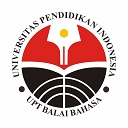War in Ippeisotsu’s by Katai Tayama
Abstract
The main objective of this research is to analyze the binary opposition contained in Ippeisotsu’s short story to reveal hidden meanings and provide new meanings about the Japan-Russia war of 1904-1905 by using the Jacques Derrida’s deconstructive reading method. This study also connects the context outside the text, namely the historical context to find the position of the work in the midst of the war situation in 1908. Therefore, Michel Foucault’s theory of power regarding discourse is used to see how the discourse related to war, the image of the ideal army, the doctrine of state defense and obedience to the emperor was constructed. Deconstructive reading method will be used to deconstruct the binary opposition found and then describe it by using qualitative descriptive method. The result of this study is there are six binary oppositions found in Ippeisotsu’s short story. These six binary oppositions are used to reveal hidden meanings and to give new meaning to the Japan-Russia war of 1904-1905. The six binary oppositions found are superior (Japan) and inferior (China), leader and follower, subject of command and object of command, brave soldier and fearful soldier, physically strong soldier and physically weak soldier, and the last is the battlefield and civilian life. If this binary opposition is related to aspects outside the text, namely connecting literary works with wartime situations, then the result of the meaning that is revealed in Ippeisotsu’s short story is a critique of the Japan-Russia war.
Keywords
Full Text:
PDF (IND)References
Buck, J. H. (1971). Education and Socialization in the Japanese Self-Defense Force. Georgia University. Diakses dari http://www.jstor.com/stable/2384256
Emzir, E., & Rohman, S. (2015). Teori dan Pengajaran
Sastra. Jakarta: Raja Grafindo Persada.
Fukurai, H., & Yang, A. (2017). The History of Japanese Racism, Japanese American Redress, and the Dangers Associated with Government Regulation of Hate Speech. Hastings Const. LQ, 45(3). Diakses dari https://repository.uchastings.edu/cgi/viewcontent.cg i?article=2064&context=hastings_constitutional_law_ quaterly
Haryatmoko, H. (2016a). Critical Discourse Analysis (Analisis Wacana Kritis): Landasan Teori, Metodologi dan Penerapan. Jakarta: Rajawali Pers.
Haryatmoko, H. (2016b). Membongkar Rezim Kepastian. Yogyakarta: PT Kanisius.
Henshall, K.G. (2015). In search of nature: The Japanese writer Tayama Katai (1872-1930), The Journal of Japanese Studies, 41(2):410-412. DOI:10.1353/jjs.2015.0058
Keene, D. (1978). The barren years. Japanese war literature. Monumenta Nipponica, 33(1), 67-112. Tokyo: Sophia University.
Lubis, A. Y. (2012). Teori dan Metodologi Ilmu Pengetahuan. Jakarta: Rajawali Press.
Purba, E.R. (2015, November). Memory, time, and space, in several Japanese atomic-bomb poems. Dipresentasikan pada Litcri ‘15 Iv. Literary Criticism Conference. Diakses dari https://www.academia.edu/39151698/LITCRI_ 15_IV_LITERARY_CRITICISM_CONFERENCE_P ROCEEDINGS
Saaler, S. (2016). Nationalism and history in contemporary Japan. The Asia-Pasific Journal, 14(7). Diakses dari https://apjjf.org/2016/20/Saaler.html
Shimazu, N. (2008). Patriotic and despondent: Japanese society at war, 1904-5. The Russian Review, 67(1), 34-49. Diakses dari http://www .jstor.org/stable/ 20620669
Sitanggang, D. (2013). Pengrusakan tempat bersejarah dalam perang antarnegara sebagai pelanggaran hukum humaniter internasional. Lex et Societatis, 1(2). Diakses dari https://ejournal.unsrat.ac.id/index.php/lexetsocietats/article/view/1745
Strecher, M. C. (2009). From Kawaraban to reportage: toward a theory for Japanese literary journalism. 立命 館 国 際 研 究 , 21(3), 491-507. Diakses dari https://dl.ndl.go.jp/info:ndljp/pid/8313472
Sugiyono, S. 2009. Metode Penelitian Kuantitatif, Kualitatif dan R&D. Bandung: Alfabeta.
Suharman, S. (2012). Kaum samurai dan ajaran bushido dalam perspektif pendidikan karakter. Akademika: Jurnal Ilmiah Kependidikan, 12. Diakses dari https:// widyasari-press.com/kaum-samurai-dan-ajaran- bushido-2/
Sulaeman, S. (2017). Isu integrasi dan disintegrasi: analisis terhadap buku teks sejarah Indonesia. Prosiding Seminar Nasional Berseri, 1(1), 145–152. Diakses dari https://proceedings.uhamka.ac.id/index.php/semnas /article/view/10
Tayama, K. (1908). Ippeisotsu. Diakses dari http://www.aozora.gr.jp
Zafarayana, D. L. (2019). Militer dalam kejahatan perang Jepang terhadap Indonesia tahun 1942-1945 studi kasus: Perbudakan seksual wanita Indonesia. Journal of International Relations, 5(1), 235-243. Diakses dari https://ejournal3.undip.ac.id/index.php/jihi/article/ view/22766
Wilson S. (1999) The Russo-Japanese War and Japan: Politics, Nationalism and Historical Memory. In: Wells D., Wilson S. (eds) The Russo-Japanese War in Cultural Perspective, 1904–05. London: Palgrave Macmillan (https://doi.org/10.1057/9780230514584_8)
DOI: https://doi.org/10.17509/japanedu.v6i2.39022
Refbacks
- There are currently no refbacks.
Copyright (c) 2021 JAPANEDU: Jurnal Pendidikan dan Pengajaran Bahasa Jepang

This work is licensed under a Creative Commons Attribution-ShareAlike 4.0 International License.
 Published by:
Published by: Department of Japanese Language Education, Faculty of Language and Literature Education
Universitas Pendidikan Indonesia
 Online ISSN: Online ISSN:2528-5548 |

JAPANEDU: Jurnal Pendidikan dan Pengajaran Bahasa Jepang (e-ISSN:2528-5548) lisenced under a Creative Commons Attribution-ShareAlike 4.0 Internasional (CC BY-SA 4.0)


